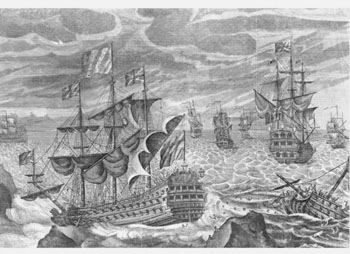
Maths in a minute: Maths and navigation
Perhaps the leading scientific question of the 17th and 18th centuries was how to find out exactly where you are when you are at sea. It had almost a mythical status and appeared in Gulliver's Travels as an example of an impossible problem. This difficult question not only stimulated a lot of mathematics, but also led, directly, to the modern world in which mathematics and machines work together.
The first breakthrough in navigation came when it was realised that the position of the Sun and the stars in the sky depend upon where you were on the (round) Earth. By seeing how the angle of the Sun changed the Greek mathematician Eratosthenes was able to calculate the radius of the Earth to surprising precision. Having worked out a coordinate system for the Earth (latitude and longitude) it was apparent that the latitude could be determined by measuring the angle of the noonday Sun above the horizon. Doing this required a good knowledge of angles and trigonometry. The angle itself could be measured using a sextant, again using ideas from trigonometry.

The Scilly naval disaster of 1707 was a direct result of sailors' inability to pin-point their longitude. 1550 men lost their lives as their ships struck rocks.
At that point the mathematics became much harder. In order to find the longitude it was necessary to determine the time at the location with reference to some absolute standard (for example, you would need to find out the local time with reference to the time in London). Mathematicians such as Newton struggled with this problem, and in a sense solved it: they found that the longitude could be determined from very accurate measurements of the location of the Moon, combined with a fearsome amount of calculation. Unfortunately, none of this was possible in the conditions at sea (and before the invention of the pocket calculator).
An accurate method of finding longitude had to wait until the development of a clock called H4 by John Harrison as a means of finding the time at Greenwich. See Dava Sobel's book Longitude for an excellent account of Harrison's struggles to build H4.
However, even with H4 a large amount of calculation was needed and here mathematics came into its own. In particular the development of spherical trigonometry, which was needed to solve the triangles on the surface of the Earth that were the results of the navigational measurements. Tables were constructed which solved triangles with a vast range of different angles. These were used in parallel with ephemerides, which were tables of the location of the Sun, planets and many stars for frequent time intervals in every day throughout the year. Looking at nautical tables from the 18th century I am overwhelmingly impressed by the amount of calculation needed to produce them, most of which would have been done by human computers.

The clockwork in Harrison's H4 clock. Photograph by Mike Peel, CC-BY-SA-4.0.
The result of all of this mathematics, combined with the mechanical brilliance of Harrison, was completely transformative. It utterly transformed navigation by sea, making it much safer and cheaper to transport goods around the world. It revolutionised both the economy and also the process of exploration, leading to the modern world.
There was a nice side product of all of this effort. The process of producing the navigational tables was essentially routine and open for being mechanised. Driven by this idea, in the 19th Century, Charles Babbage was inspired to design the difference engine, arguably the ancestor of all modern computers. Sadly, Babbage did not live to see his machines actually working (although a working model of the difference engine was built by the Science Museum in London), but his ideas have certainly led to the modern computer, and thus the modern world.Further reading
You can find out more in the following articles:
- Finding your place in the world explains the global coordinates of latitude and longitude,
- Latitude by the stars explains how latitude can be determined by measuring the angle of the Sun above the horizon,
- The longitude problem explains just that,
- Ada Lovelace: visions of today explores Babbage's attempt at building the first ever computer, and the contributions of his friend Ada Lovelace.
About this article

Chris Budd.
This article is adapted from one of Chris Budd's Gresham College lectures, part of a series called Mathematics and the making of the modern and future world. The lectures take place in London, are aimed at a general audience and free to attend.
Chris Budd OBE is Professor of Applied Mathematics at the University of Bath, Vice President of the Institute of Mathematics and its Applications, Chair of Mathematics for the Royal Institution, Gresham Professor of Geometry, and an honorary fellow of the British Science Association. He is particularly interested in applying mathematics to the real world and promoting the public understanding of mathematics.
He has co-written the popular mathematics book Mathematics Galore!, published by Oxford University Press, with C. Sangwin and features in the book 50 Visions of Mathematics ed. Sam Parc.